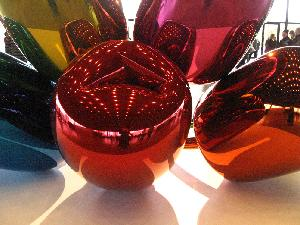While waiting in the long queue in front of the Neue Nationalgalerie these days, one has the opportunity to experience once more that forgotten child-like enthusiasm before a magical encounter at the puppet theatre. The shows on display until February fascinate the visitors from two different standpoints: the grand and the minute; 11 giant sculptures by American contemporary artist Jeff Koons are hosted under the same roof as about 250 paintings of the Swiss artist Paul Klee. After completing the essay of the week, ECLA students approached both exhibitions with greedy eyes, re-tracing the “Cult of the Artist” theme, which major museums of Berlin are currently employing to organize their exhibits; in the present case, the focus was modern art. Not accidentally, the winter term will offer an entire elective course on the Cult of the Artist, coordinated by art historian and ECLA professor, Aya Soika.
The “Koons Celebration” series, which covers the entire ground floor of the museum, toys with the visitors’ perception by transposing everyday objects into immense, brightly-colored sculptures which unmistakably refer to childhood. The artworks produce the unreal, yet playful sensation of the viewer being very tiny. Who would have thought that the world-famous Balloon Dog in its red version would be so big, so stainless-steel-shiny, and yet so adorable? The pieces on display at the Neue Nationalgalerie are the result of a preoccupation of the artist with sculpture since 1994, and the present show gathers the largest number of such works at once. While lingering at each one, we recognized our tired reflections in the perfectly polished surfaced of Koons’ Diamond (Yellow) or Hanging Heart (Violet / Gold) and pondered the contemporary art market.
Although Koons entertained our imaginations, the final destination of our class visit was Paul Klee, or more precisely, the large grouping of pictures on display amounting to only 3 percent of his prolific output. We descended to the basement of the museum, and were told by our guide that the architect of building (Ludwig Mies van der Rohe) was a collector of Klee’s works. Where could be a more fitting a location to present a part of the artist’s creative universe? The entire exhibition is structured around 15 themes recalling the artists’ theoretical considerations about the universal character of art, which, in its essence, accompanies and represents human life from its magical inception until its melancholic demise. The person of the artist, as well as his worldview and theory of aesthetics become transparent in some of his most widely discussed works, which were also the focus of our attention: “Ad marginem”, “The Sealed Lady ( versiegelte Dame)”, “Angelus Novus”, and “Highways and Byways (Hauptweg und Nebenwege)”. The title of this last piece is also the title of Heinz Berggruen’s biography; he was one of the most ardent consumers of Klee’s work, having collected a very large number of paintings, and contributed to the planning of the present Klee Universum exhibit until his recent death in 2007.
Childhood, Eros, travels, theater, animals, nature, music, architecture, Bauhaus, script, religion, war, and melancholy are points of reference for the artist. Out of these one can reconstruct the most relevant experiences in Klee’s philosophic and artistic development, leading to his ascription of an integrative role for art: “art does not reproduce the visible; rather, it makes visible.”
He found great insight and value in children’s visual representation of the universe surrounding them, and involved himself with artists displaying the same inclinations, like Kandinsky and his “Blue Rider” expressionist circle. His fascination with forms and elements outside the canon urged Klee to pursue the artistic expressions of non-European cultures. His travels to Tunisia and Egypt further inspired the themes of colour, composition, and rhythm, which were never absent from his painting. Music was the medium of the first artistic manifestations of young Klee, thus he often quoted and employed it as a concept, at times in praise of childhood and its creative strength.
The ten years Klee spent as a Bauhaus professor imprinted a tendency toward abstraction and the predominance of dynamic and architectural motifs in his work. Arrows, letters, and vivid colour are intensively used for their power to communicate with and incite the viewer to contemplation. One can perceive a foreshadowing of what was to be coined conceptual art in Klee’s use of script, and also in the theoretical considerations behind his works. His post-1933 work deals with the pressure of having had his art publicly contested as “degenerate art”, and transmits the violence behind the Nazi threat in paintings which appear unfinished or repudiated–collage portraits crossed by long black strokes of the brush.
A world of interpretations surrounds one of the central pieces of the exhibit; the 1920 painting entitled “Angelus Novus”, which has been commented as Klee anticipating the advent of dictatorship in Germany. Having owned this painting, the philosopher Walter Benjamin used the image to metaphorically contour his concept of history: “An angel is depicted there who looks as though he were about to distance himself from something which he is staring at. His eyes are opened wide, his mouth stands open and his wings are outstretched. The Angel of History must look just so. His face is turned towards the past. Where we see the appearance of a chain of events, he sees one single catastrophe, which unceasingly piles rubble on top of rubble and hurls it before his feet. He would like to pause for a moment so fair, to awaken the dead and to piece together what has been smashed. But a storm is blowing from Paradise, it has caught itself up in his wings and is so strong that the Angel can no longer close them. The storm drives him irresistibly into the future, to which his back is turned, while the rubble-heap before him grows sky-high. That, which we call progress, is this storm.”
By Brindusa Birhala (’09, Romania)

